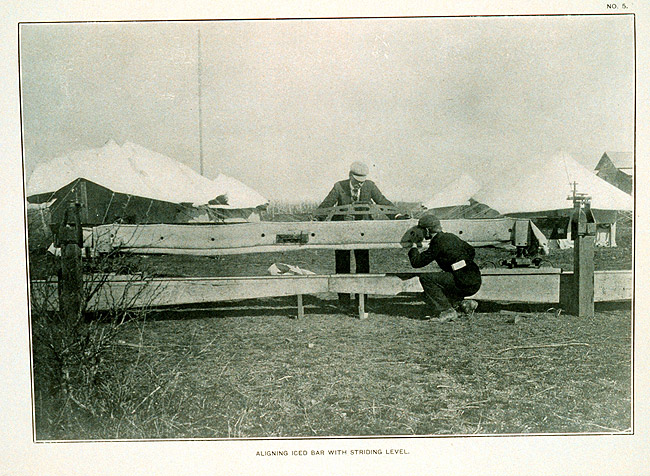 Great Theodolite
Great Theodolite The Bache- Wurdemann Compensating Device
The Bache- Wurdemann Compensating Device Eimbeck Duplex Bars
Eimbeck Duplex Bars Iced Bar B 17
Iced Bar B 17 Steel Tape with Tape Stretcher
Steel Tape with Tape Stretcher Invar Tape
Invar Tape AGA Geodimeter NASM-2A
AGA Geodimeter NASM-2A Tellurometer Model M/RA 1
Tellurometer Model M/RA 1 Laser Signal and Prismatic Mirror Reflecting System
Laser Signal and Prismatic Mirror Reflecting System AGA Geodimeters, Models 4D and 4L
AGA Geodimeters, Models 4D and 4L Big Red
Big Red AGA Geodimeter Model 6
AGA Geodimeter Model 6 Hewlett-Packard Model 3800B Distance Meter
Hewlett-Packard Model 3800B Distance Meter Tellurometer Model MA-100
Tellurometer Model MA-100 Ranger III and Rangemaster III
Ranger III and Rangemaster III Topcon ET-1 Total Station
Topcon ET-1 Total Station Trimble GPS Antenna
Trimble GPS Antenna
Iced Bar B 17
In this photograph, an iced-bar apparatus is being aligned with a striding level. This apparatus, designed in ongoing efforts to combat the problem of thermal expansion of metal rods used to measure distances, is essentially a bar covered with ice. In 1891, nine man-days were allocated for building an ice house at Holton, Indiana, to store the ice needed for the device.

In the photo above, surveyors are leveling the iced bar. Nine man-days were allocated for building an ice house to store the necessary ice at Holton, Indiana.
In 1891 and 1892, another approach to controlling the effect of temperature on metal bars was extensively tested. A five-meter steel bar known as "B 17" was covered in melting crushed ice in a Y-shaped trough. The bar was supported on rollers and mounted on two three-wheel cars that ran on portable tracks. Micrometer microscopes at the ends of the bars were used to align the bars they were moved forward to measure a distance. The process of moving B 17 and measuring distances with the microscopes was not speedy: the crew averaged 0.06 miles per hour!
Despite the slow pace it required, B 17 proved to be highly accurate. Rigidly standardized against the International Prototype Meter, it was used as the standard unit of length to which Eimbeck duplex bars and steel tapes were compared in 1900, when nine separate base lines were measured from O'Neil, Nebraska to Alice, Texas, in preparation for the historic 98th meridian arc of triangulation survey. B 17 remained the standard for some time, including in 1906, when steel tapes were compared with tapes formed of a nickel-steel alloy called invar, for the first time.
Historical Reference
Initially, the Coast Survey standardized its own equipment, which is not surprising since Superintendent Ferdinand Hassler had also been the first Superintendent of the Office of Weights and Measures. Eventually, the agency now known as the National Institute of Science and Technology evolved out of the need for the calibration of bars and tapes used by the Coast Survey.
- Distance Measurement Instrument Shown: Iced bar B 17
- Location: Midwestern United States
- Manufacture Date: 1890s
- Dates of Use: Late 1800s - Early 1900s
- Photo Date: 1901/1902?
Works Consulted
Baldwin, A. L. (1902). On the Measurement of Nine Bases Along the Ninety-Eighth Meridian. [Electronic version] Report of the Superintendent of the Coast and Geodetic Survey Showing the Progress of the Work from July 1, 1900, to June 30, 1901. p. 229 -302.
Mosman, A. T. (1892). On the Measurement of the Holton Base, Holton, Ripley County, Indiana, and the St. Albans Base, Kanawha County, West Virginia [Electronic Version]. Report of the Superintendent of the Coast and Geodetic Survey for the Fiscal Year Ending June 30,1892. p 329-503.
Related Web Sites
